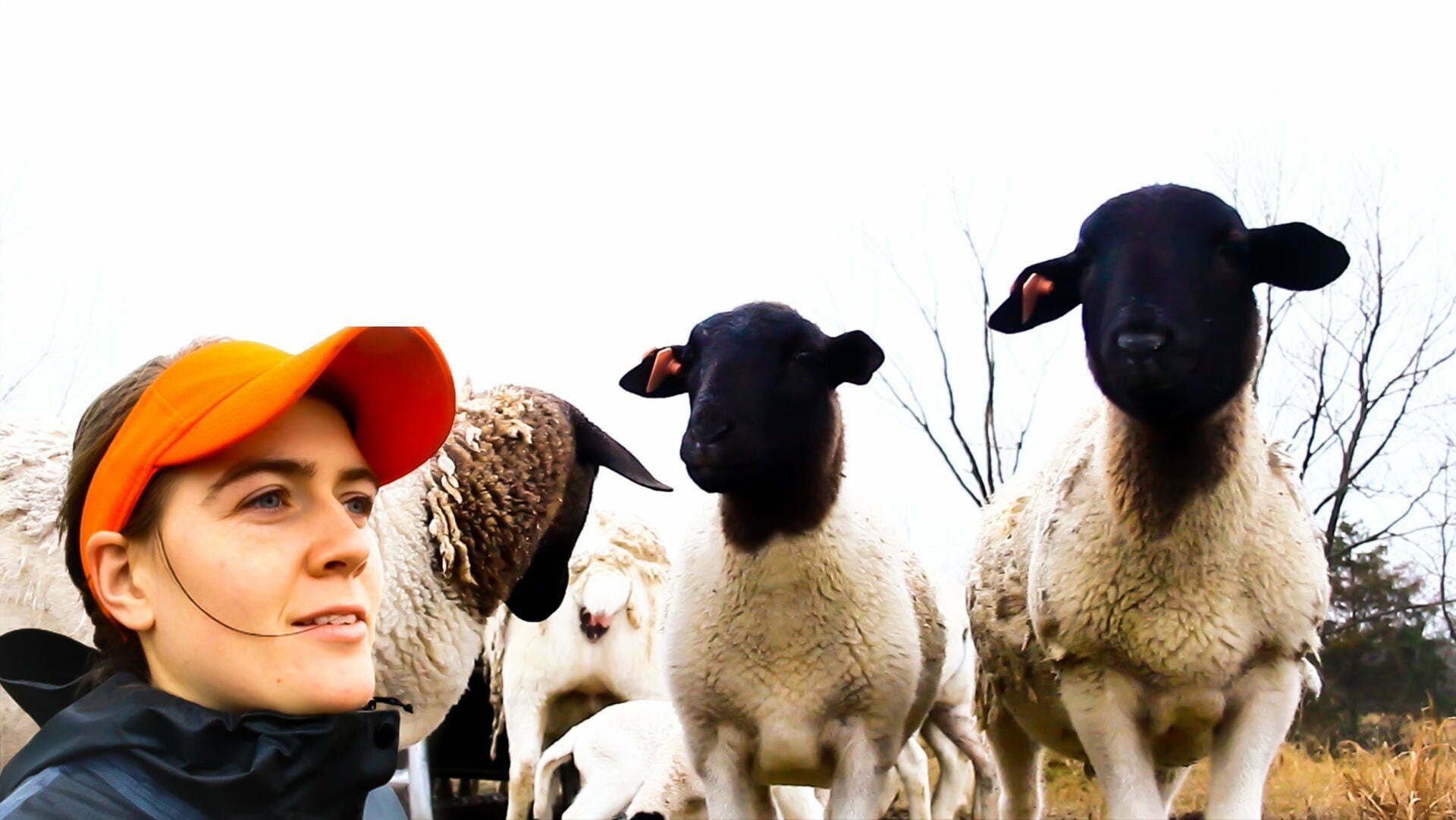CLICK FOR MY FREE E-BOOK “13 Things You Need to Raise Sheep”

Does lye work as a natural dewormer for livestock? In this article I am going to share vet-tested results that will give you the answer. I am going to share exactly how I administered lye to act as a dewormer, the animals I ran this test on, and the detailed results from the veterinary office which reveal how effective (or not) that lye is as a natural dewormer for livestock.
Very interesting stuff is upcoming, so let’s get to it.
Premise:
If you are like me, you’ve seen or received a message about the VIRAL “Lye as a Natural Dewormer for livestock videos”: pigs, sheep, goats, cattle, chickens… The viral video claims that Lye works as a dewormer for all classes of livestock. The man who published the video says that he has been using lye as livestock dewormer for 17 years with no negative side effects observed in his animals. He cites that lye has no meat withdrawal period, and no milk withdrawal period.
Withdrawal period is a time period in which you cannot eat the meat or drink the milk of an animal that has been dewormed with chemical dewormer. Withdrawal period is necessary because chemical residuals may present themselves in either the meat or the milk directly after using chemical dewormers. The withdrawal time period ranges from 2-8 weeks depending on what kind of chemical dewormer you are using.
In watching that video, I was intrigued but skeptical. Intrigued because the animals looked healthy, skeptical because there was no real data provided that connected the health of the animals to the lye, just sort of a “I think it works and it’s what I use”. There were no fecal egg counts done to confirm that the lye was actually (the thing) reducing parasite loads.
So I decided to perform an informal research project for myself: to gather the numbers and data that was missing.
Here is exactly how it went:
But first a quick disclaimer: this Article is in no ways encouraging you to use lye as a dewormer for your livestock. Lye is caustic and may kill your animal. This is purely a research project. I am not a veterinarian, so please contact yours before giving anything to your animal as a dewormer.
Back to it:
My Test Subjects & Conditions
I used my small goat herd to test the lye as a dewormer concept. The herd is about 7 head in total: 2 kids (6 mos old) and 5 adults.
I tested this small group of goats instead of my sheep flock because (given the previous disclaimer) I was not sure if the lye would kill my animals. I can afford to lose my goats, but if I were to kill my sheep flock through this experiment I would be out a significant amount of money.
My goats are dairy goats. One of the adult nannies was pretty badly infected with parasites at the onset of this experiment (namely the barber’s pole worm), as indicated by a very severe case of bottle jaw. She was a good test subject.
To begin this research project I removed the goats from the pasture and put them in a pen.
I controlled their feed 100%: giving them a 50-50 ration of all stock feed pellets and alfalfa pellets. I also provided bermuda hay free choice.
Now removing the goats entirely from pasture and putting them into a controlled environment for the duration of this test eliminated any external factors that would either increase or decrease their parasite counts. This gave me a crystal-clear idea of exactly what kind of impact the lye treatment did or did not have on parasite counts.
The Process (and Results):
Once I penned the goats I ran the first of 3 fecal egg counts to find out how many parasites/worms were inside these goats.
Fecal egg counts are the primary means of determining whether a deworming method is effective. You must run a fecal egg count both before and after you deworm your animal. If a given deworming method is effective, there will be a significant reduction in the egg count numbers in that second test.
To run the fecal egg count you need to take roughly 4-5 pieces of goat or sheep manure to the vet. From there, the vet will provide you with egg count on the manure samples. According to my vet, 800 eggs per gram or less is what you want to aim for in your sheep and goats. Numbers higher than this represent a pretty significant parasite infection.
I ran a fecal egg count on 2 of the 7 goats in this test group: Daisy (with the bottle jaw) and Maria.
Results from test #1 showed an egg count of:
- 5400 eggs per gram for Daisy
- 1250 eggs per gram for Maria
Which means both goats were significantly infected with the Barber’s Pole Worm – far beyond 800 epg.
After this first test I gave lye as a dewormer for the first time. I followed instructions almost exactly from that viral video for my 7 goats:
- 1 teaspoon of lye
- 2 cups water
- 2 gallons of feed
I dissolved 1 teaspoon of lye in the water, poured the water into the feed and thoroughly mixed it to where all of the feed was covered in the lye-water.
Then fed it to the goats.
Two days later I took a 2nd round of fecal samples from Daisy and Maria to the vet for the second test.
Results from test #2 showed a fecal egg count of:
- 1200 eggs per gram for Daisy (down from 5400)
- 750 eggs per gram for Maria (Down from 1250)
Now this was a significant reduction, but these numbers were still really high. As a reminder: 800 epg is about maximum in terms of healthy levels.
So at this point, I took a risk and administered a second round of lye treated feed.
The same protocol as the first time around:
- 1 teaspoon of lye
- 2 cups water
- 2 gallons of feed
2 days after that second dose I took a 3rd set of fecal samples from Daisy and Maria to the vet for a 3rd test.
The vet called with the results from that 3rd test and said: there are no worms in these samples.
I said: “What do you mean, there are always some worms, what are the numbers?”
The vet-tech said: “the numbers are so low that it’s not worth counting, but I’d say around 150epg for Daisy and 300epg for Maria”. I was floored and shocked.
Results from test #3 showed a fecal egg count of:
- 150 eggs per gram for Daisy (down from 5400)
- 300 eggs per gram for Maria (Down from 1250)
So yes, lye dewormed my goats almost completely. I observed no negative side effects despite giving the treatment twice in one week.
So what are your thoughts? Is this too risky? Have you had success using lye as a dewormer yourself? Would you use Lye to deworm your own animals? Have you encountered negative side effects in using lye as a dewormer? I am looking forward to this conversation continuing in the comments!

I believe the reason this method is discouraged, big.pharma.ag does not benefit and in fact looses out…
about 2 months ago I purchased two pregnant cows and two cow calf pairs at the auction. I’m trying to rebuild my herd after having to sell off after Hurricane Helene destroyed miles of fencing. several of the cows were quite thin with ribs showing. and one of them had significant bottle jaw. I did the same deworming with lye as I saw in that video. within a few days, the bottle jaw of the cow had significantly decreased. I gave them a second treatment with the lye solution and feed yesterday. I haven’t done any fecal egg count tests, but I can certainly tell from the bottle jaw reduction that it seems to be working. I lost so many sheep to Barber pole worms the first five or six years after getting into sheep. but the survivors I have now are the most resistant I guess. but I’m definitely going to feed them the lye solution with feed.